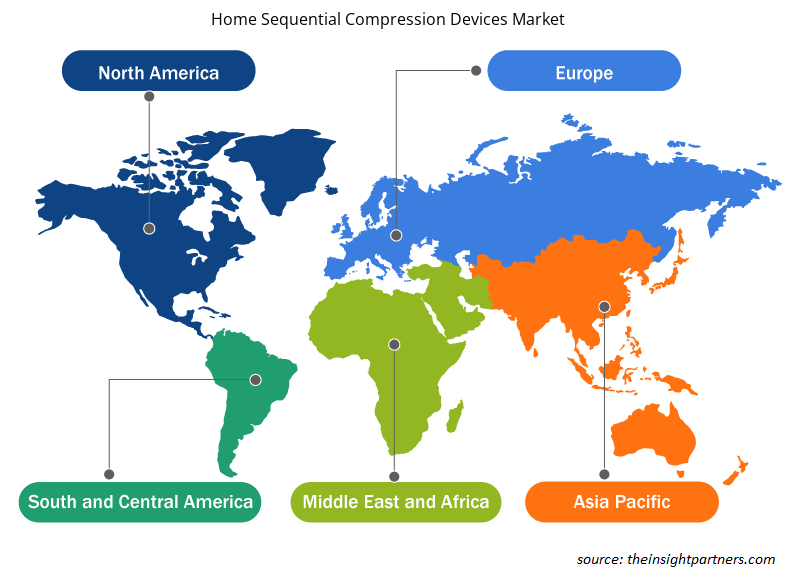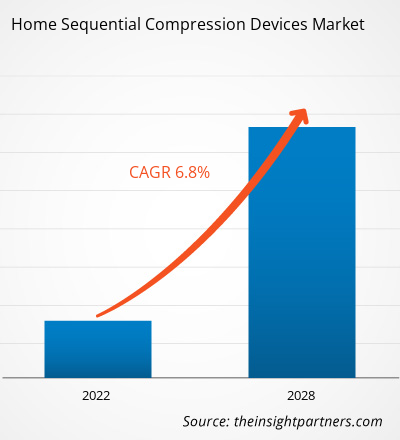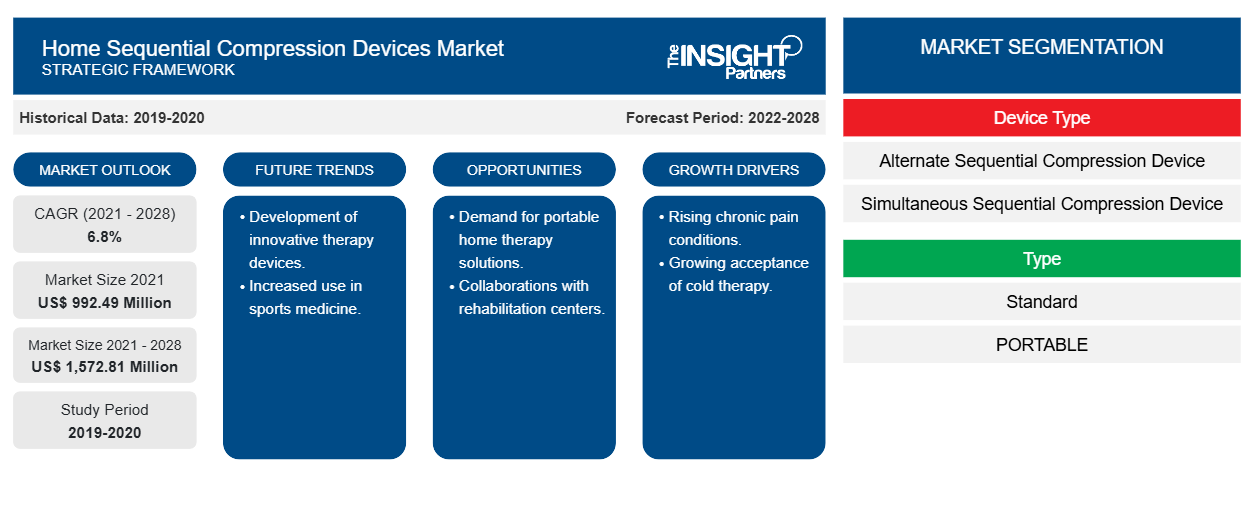El mercado de dispositivos de compresión secuencial para el hogar se valoró en US$ 992,49 millones en 2021 y se proyecta que alcance los US$ 1.572,81 millones para 2028; se espera que crezca a una CAGR del 6,8% entre 2021 y 2028.
El dispositivo de compresión secuencial para uso doméstico (SCD, por sus siglas en inglés) es un dispositivo de prevención de TVP que aumenta el flujo sanguíneo en las piernas. Los SCD tienen forma de "mangas" que envuelven las piernas y se inflan una a la vez con aire. Esto simula la marcha y ayuda a prevenir los coágulos de sangre. Cuando esté en la cama o sentado en una silla, debe usar SCD. Para caminar, debe quitarse los SCD. Se espera que el mercado de dispositivos de compresión secuencial para uso doméstico experimente un crecimiento significativo en los próximos años debido a factores como el aumento de la prevalencia de trastornos linfáticos y venosos y la creciente conciencia sobre el tratamiento avanzado que implica el uso de compresión secuencial y otros dispositivos que impulsan el crecimiento del mercado. Sin embargo, la disponibilidad de terapias alternativas obstaculiza el crecimiento del mercado.
Personalice este informe según sus necesidades
Obtendrá personalización en cualquier informe, sin cargo, incluidas partes de este informe o análisis a nivel de país, paquete de datos de Excel, así como también grandes ofertas y descuentos para empresas emergentes y universidades.
- Obtenga las principales tendencias clave del mercado de este informe.Esta muestra GRATUITA incluirá análisis de datos, desde tendencias del mercado hasta estimaciones y pronósticos.
Perspectivas del mercado
Prevalencia de trastornos linfáticos y venosos
Los dispositivos de compresión secuencial (SCD) se utilizan como parte de la tromboembolia venosa (TEV). Según el Centro para el Control y la Prevención de Enfermedades (CDC), la coagulación de la sangre en una vena profunda da lugar a la TEV, que es principalmente una afección de los vasos sanguíneos. Estos coágulos generalmente se desarrollan en la parte inferior de la pierna, el muslo o la pelvis, y las lesiones en las venas, el flujo sanguíneo lento, el aumento de los niveles de estrógeno, las enfermedades cardíacas y la obesidad se encuentran entre las principales causas de la formación de coágulos. Según un estudio publicado por StatPearls Publishing LLC en agosto de 2020, se informa que más de 200.000 personas en los EE. UU. desarrollan trombosis venosa anualmente. Además, según Thrombosis UK, 1 de cada 1000 personas sufre trombosis venosa cada año. Los trastornos venosos son causados por factores como el embarazo, la obesidad, las venas varicosas y la insuficiencia venosa. La insuficiencia venosa se observa durante el embarazo debido principalmente a un útero grávido agrandado, lo que provoca hipertensión en las venas de las extremidades inferiores y un aumento de la secreción hormonal, lo que debilita las paredes de las venas. Por lo tanto, la creciente prevalencia de trastornos linfáticos y venosos está impulsando la demanda de dispositivos de compresión secuencial para uso doméstico, lo que impulsa el crecimiento del mercado.
Información sobre el tipo de dispositivo
Según el tipo de dispositivo, el mercado de dispositivos de compresión secuencial para el hogar se segmenta en dispositivos de compresión secuencial alterna (ASCD) y dispositivos de compresión secuencial simultánea (SSCD). El segmento de dispositivos de compresión secuencial simultánea (SSCD) tuvo una mayor participación en el mercado en 2021 y se prevé que registre una CAGR más alta en el mercado durante el período de pronóstico.
Información sobre tipos
Según el tipo, el mercado de dispositivos de compresión secuencial para el hogar se segmenta en estándar y portátil. En 2021, es probable que el segmento estándar tenga una mayor participación en el mercado y crezca al ritmo más rápido durante los próximos años.
Solicitud
Según la aplicación, el mercado de dispositivos de compresión secuencial para el hogar se segmenta en trombosis venosa profunda (TVP), tratamiento del linfedema, insuficiencia venosa crónica (IVC) y otros. Es probable que el segmento de trombosis venosa profunda (TVP) tenga la mayor participación del mercado en 2021 y se prevé que registre la CAGR más alta del mercado durante el período de pronóstico.
Los actores que operan en el mercado de dispositivos de compresión secuencial para el hogar han estado adoptando principalmente la estrategia de innovación de productos para satisfacer la cambiante demanda de los clientes en todo el mundo, lo que también les permite mantener su marca a nivel mundial.
Inicio Dispositivos de compresión secuencial Perspectivas regionales del mercado
Los analistas de Insight Partners explicaron en detalle las tendencias y los factores regionales que influyen en el mercado de dispositivos de compresión secuencial para el hogar durante el período de pronóstico. Esta sección también analiza los segmentos y la geografía del mercado de dispositivos de compresión secuencial para el hogar en América del Norte, Europa, Asia Pacífico, Oriente Medio y África, y América del Sur y Central.

- Obtenga datos regionales específicos para el mercado de dispositivos de compresión secuencial para el hogar
Inicio Alcance del informe de mercado de dispositivos de compresión secuencial
| Atributo del informe | Detalles |
|---|---|
| Tamaño del mercado en 2021 | US$ 992,49 millones |
| Tamaño del mercado en 2028 | US$ 1.572,81 millones |
| CAGR global (2021-2028) | 6,8% |
| Datos históricos | 2019-2020 |
| Período de pronóstico | 2022-2028 |
| Segmentos cubiertos | Por tipo de dispositivo
|
| Regiones y países cubiertos | América del norte
|
| Líderes del mercado y perfiles de empresas clave |
|
Inicio Dispositivos de compresión secuencial Densidad de actores del mercado: comprensión de su impacto en la dinámica empresarial
El mercado de dispositivos de compresión secuencial para el hogar está creciendo rápidamente, impulsado por la creciente demanda de los usuarios finales debido a factores como la evolución de las preferencias de los consumidores, los avances tecnológicos y una mayor conciencia de los beneficios del producto. A medida que aumenta la demanda, las empresas amplían sus ofertas, innovan para satisfacer las necesidades de los consumidores y aprovechan las tendencias emergentes, lo que impulsa aún más el crecimiento del mercado.
La densidad de actores del mercado se refiere a la distribución de las empresas o firmas que operan dentro de un mercado o industria en particular. Indica cuántos competidores (actores del mercado) están presentes en un espacio de mercado determinado en relación con su tamaño o valor total de mercado.
Las principales empresas que operan en el mercado de dispositivos de compresión secuencial para el hogar son:
- Salud Cardenal Inc.
- Sistemas de biocompresión
- DJO Global, Inc.
- DS MAREF CO.LTD
- Productos médicos de precisión
Descargo de responsabilidad : Las empresas enumeradas anteriormente no están clasificadas en ningún orden particular.

- Obtenga una descripción general de los principales actores clave del mercado de dispositivos de compresión secuencial para el hogar
Por tipo de dispositivo
- Dispositivo de compresión secuencial simultánea (SSCD)
- Dispositivo de compresión secuencial alternativa (ASCD)
Por tipo
- Estándar
- Portátil
Por aplicación
- Trombosis venosa profunda (TVP)
- Tratamiento del linfedema
- Insuficiencia venosa crónica (IVC)
Por geografía
América del norte
- A NOSOTROS
- Canadá
- México
Europa
- Reino Unido
- Alemania
- Francia
- Italia
- España
- Resto de Europa
Asia Pacífico
- Porcelana
- Japón
- India
- Australia
- Corea del Sur
- Resto de Asia Pacífico
Oriente Medio y África
- Emiratos Árabes Unidos
- Arabia Saudita
- Sudáfrica
- Resto de Oriente Medio y África
América del Sur y Central
- Brasil
- Argentina
- Resto de América del Sur y Central
Perfiles de empresas
- Salud Cardenal Inc.
- SISTEMAS DE BIOCOMPRESIÓN
- DJO Global, Inc.
- Compañía DSMAREF, Ltd.
- Productos médicos de precisión
- AIROS Médico
- Compañía Inc.
- Mego Afek Ltd.
- Dispositivos médicos Arjo
- Medicina táctil
- Análisis histórico (2 años), año base, pronóstico (7 años) con CAGR
- Análisis PEST y FODA
- Tamaño del mercado, valor/volumen: global, regional y nacional
- Industria y panorama competitivo
- Conjunto de datos de Excel
Informes recientes
Testimonios
Razón para comprar
- Toma de decisiones informada
- Comprensión de la dinámica del mercado
- Análisis competitivo
- Información sobre clientes
- Pronósticos del mercado
- Mitigación de riesgos
- Planificación estratégica
- Justificación de la inversión
- Identificación de mercados emergentes
- Mejora de las estrategias de marketing
- Impulso de la eficiencia operativa
- Alineación con las tendencias regulatorias





















 Obtenga una muestra gratuita para - Mercado de dispositivos de compresión secuencial para el hogar
Obtenga una muestra gratuita para - Mercado de dispositivos de compresión secuencial para el hogar